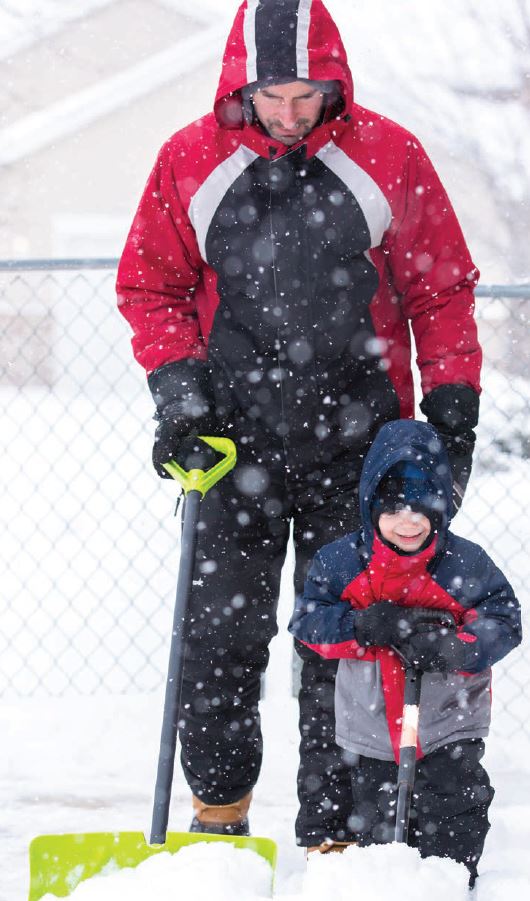Simple steps you take today can help you have an injury-free season.
 Fire and ice, two unavoidable elements of winter living, can present major safety risks. This year, be prepared with these seasonal safety tips from Christopher Freer, DO, Clinical Chairperson of Emergency Medicine at Saint Barnabas Medical Center (SBMC), and Michael Marano, MD, Medical Director of The Burn Center at SBMC.
Fire and ice, two unavoidable elements of winter living, can present major safety risks. This year, be prepared with these seasonal safety tips from Christopher Freer, DO, Clinical Chairperson of Emergency Medicine at Saint Barnabas Medical Center (SBMC), and Michael Marano, MD, Medical Director of The Burn Center at SBMC.
RISK:
Falls on Ice
About 36,000 people die from falls each year, according to the U.S. Centers for Disease Control and Prevention, and many more suffer head injuries and bone fractures.
PREVENTION:
Don’t trust your eyes. Black ice gets its name because it’s invisible. If the temperature is below freezing, assume that surfaces are slippery.
Forgo fancy footwear. Make sure that your outside footwear has good traction, ideally with rubber soles and treads.
Take extra care if you’re older. Have eyes and feet checked regularly, and do exercises to improve balance and strength.
Put pride aside. Consider using a cane or walking stick to help you navigate outdoors, or ask a friend for an arm to lean on over icy patches.
RISK:
Viral and Bacterial Infections
Flu season peaks between December and March, and other infections—colds, gastrointestinal bacteria and viruses, strep throat—are also more likely in the winter.
PREVENTION:
Wash your hands frequently, especially if you’ve shaken hands with anyone or touched any public surfaces like door handles or ATM screens.
Carry an antibacterial spray or gel. When you can’t get to a sink, using one of these products is the next best thing.
Get out of touch. Avoid touching your eyes, nose or mouth as much as possible to minimize the chance of catching a flu or other bug.
Get vaccinated. Everyone 6 months and older should g et the flu vaccine. “It will reduce your chance of catching the flu, and if you do c ach it, you are less likely to become seriously ill,” says Dr. Freer.
Take care of your health. A nutritious diet and at least seven hours of sleep every night will help keep your immune system strong.
RISK:
Hypothermia and Frostbite
Hypothermia is abnormally low body temperature caused by prolonged exposure to cold temperatures. Symptoms include shivering, exhaustion and confusion. Frostbite (the freezing of body parts like fingers and toes) can be indicated by numbness and a whitish patch of skin. If you see signs of either condition, take immediate action.
PREVENTION:
Dress warmly. “That includes hats, gloves and multiple layers,” says Dr. Freer. If clothing gets wet, change it immediately.
Don’t drink alcohol and then spend time outside when it’s cold. “People may not realize they’re getting hypothermic when they’re impaired,” says Dr. Freer.
Check on older friends and relatives. “If the heat isn’t working, they can get hypothermia, even though they’re inside,” says Dr. Freer.
RISK:
Overexertion/Heart Attacks
Recent studies have indicated a physiological link between colder temperatures and heart risks.
PREVENTION:
Stay warm. This is critical because cold temperatures can slow down the flow of blood and potentially cause blood clots to form.
Be careful about shoveling. “If you’re over 50, out of shape and go outside in the cold and start doing strenuous upper body exercise, like shoveling, you’re at risk of having a heart attack,” says Dr. Freer. It that’s the case, get someone else to do the shoveling. Also, beware the snow blower. “Don’t put your hand in or near the machine to remove snow,” says Dr. Freer. “Every winter storm, we see several patients with amputated fingers due to snow blowers.”
Be mindful about holiday celebrations. The incidence of heart attacks tends to spike during the winter holiday season, possibly related to dietary overindulgence—or because people tend to put off getting troubling symptoms checked during the holidays.
RISK:
Carbon Monoxide Poisoning
Carbon monoxide (CO) is a colorless, odorless, tasteless gas that’s produced by burning fossil fuels (gasoline, wood, propane and charcoal). When breathed in, CO replaces oxygen in red blood cells, causing illness and even death. “Signs include headache, nausea and symptoms that can be mistaken for a common headache or viral illness,” says Dr. Freer.
PREVENTION:
Install battery-operated carbon monoxide detectors. Check them regularly.
Have your furnace serviced regularly by a professional.
Heat and cook with care. Don’t use a generator, charcoal grill, camp stove or other gasoline or charcoal-burning device inside your home, basement or garage, or near a window. Use an extension cord that is more than 20 feet long to keep a generator at a safe distance from the house.
RISK:
House Fires
“Winter is our busiest season in The Burn Center,” says Dr. Marano. “Any time people are inside trying to stay warm, there’s a risk of fire and smoke inhalation.”
PREVENTION:
Make sure there are smoke and carbon monoxide detectors in your living space, especially in the kitchen and bedrooms.
Have fire extinguishers handy, especially in the kitchen and near a working fireplace.
Be smart about space heaters. Get the kind that will turn off automatically if knocked over. Keep it as far away from curtains and furniture as possible.
Consider LED candles. “Everyone loves candles, but they can be dangerous,” says Dr. Marano. “LED candles look like the real thing but don’t carry the same risk.”
Maintain your holiday tree. “Keep it watered or get a fake one,” says Dr. Marano. “Dry branches and needles are a fire risk.”
Keep young children out of the kitchen. “Children getting underfoot and causing accidents or getting burned are some of the major reasons we see for visits to The Burn Center,” says Dr. Marano.
To find a physician at Saint Barnabas Medical Center, call 888.724.7123 or visit www.rwjbh.org/doctors.